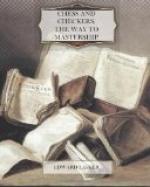+---------------------------------------+ 8 | #R | | #B | #Q | #K | | | #R | |---------------------------------------| 7 | #P | #P | #P | #P | #B | #P | #P | #P | |---------------------------------------| 6 | | | #Kt| | | #Kt| | | |---------------------------------------| 5 | | | | | | | | | |---------------------------------------| 4 | | | ^B | #P | ^P | | | | |---------------------------------------| 3 | | | | | | ^Kt| | | |---------------------------------------| 2 | ^P | ^P | ^P | | | ^P | ^P | ^P | |---------------------------------------| 1 | ^R | ^Kt| ^B | ^Q | | ^R | ^K | | +---------------------------------------+ a b c d e f g h
Diagram 59.
A game played with this opening proceeded as follows: (6) P-e5, Kt-e4; (7) B-d5, Kt-c5; (8) Ktxd4, Ktxd4; (9) Qxd4, o-o; (10) Kt-c3, P-d6; (11) B-e3, P-c6; (12) B-b3, P-d5; (13) Ra1-d1, K-h8; (14) Q-f4, P-f6. This decides the middle-game in Black’s favor. Not only will he have superior mobility with his Rooks, but his two Bishops are much stronger than White’s two minor pieces, especially as White’s Bishop is shut in.
+---------------------------------------+ 8 | #R | | #B | #Q | #K | #B | #Kt| #R | |---------------------------------------| 7 | #P | #P | #P | #P | | #P | #P | #P | |---------------------------------------| 6 | | | | | | | | | |---------------------------------------| 5 | | | | | | | | | |---------------------------------------| 4 | | | | ^Q | ^P | | | | |---------------------------------------| 3 | | | | | | | | | |---------------------------------------| 2 | ^P | ^P | ^P | | | ^P | ^P | ^P | |---------------------------------------| 1 | ^R | ^Kt| ^B | | ^K | ^B | | ^R | +---------------------------------------+ a b c d e f g h
Diagram 60.
Moreover, Black has the better chances even in the ending, as he has a majority of Pawns on the Queen’s wing. After all pieces have been exchanged, these Pawns would finally result in a passed Pawn, which White would have to stop with his King while Black can leisurely attack the Pawns of the King’s side.
A disadvantage due to Pawn moves which up to now has not yet been discussed is the weakness of so-called “backward Pawns.” A backward Pawn is one whose adjoining kindred Pawns have advanced while he is unable himself to advance far enough to obtain their protection from a frontal or diagonal attack. In the position of Diagram 60, for instance, Black would make his Queen’s Pawn backward if he played P-c5; for if White handles the game right Black will never be able to advance the Queen’s Pawn beyond d6, making him an easy mark for an attack in the d-file or in the diagonal h2-b8, and also hampering the mobility of Black’s pieces in the center. The correct way for White to arrange his men would be to play P-c4 and after the development of the minor pieces to double the Rooks in the d-file. White’s Queen’s Bishop will be placed best on f4 from where he helps pressing on d6.




